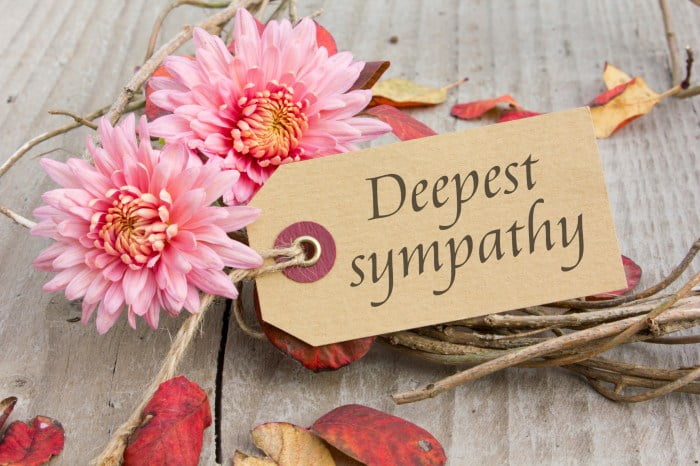In the face of loss, words often fail to capture the depth of sorrow and pain. Yet, during times of bereavement, the expression of condolences can provide a beacon of comfort and support to those grieving. This guide delves into the nuances of crafting meaningful bereavement condolence messages, exploring cultural and religious considerations, etiquette and protocol, and resources for support and counseling.
From heartfelt written messages to compassionate verbal expressions and symbolic gestures, this comprehensive resource offers guidance on navigating the delicate task of expressing condolences with empathy, understanding, and respect. Whether you’re a close family member, a dear friend, or a colleague offering support, this guide will equip you with the knowledge and tools to convey your deepest sympathies in a manner that honors the memory of the departed and brings solace to the grieving.
Understanding Bereavement Condolence Messages

During times of grief and sorrow, expressing condolences is a meaningful gesture that acknowledges the loss and offers comfort to the bereaved. These messages convey empathy, support, and solidarity, helping the grieving individuals navigate their emotional journey.
Types of Bereavement Condolence Messages
Condolence messages can be conveyed through various forms, including written, verbal, and symbolic gestures. Each type has its own significance and can be tailored to the specific circumstances and preferences of the bereaved.
- Written Messages: These can be formal or informal letters, cards, or emails expressing sympathy and support. They allow for thoughtful reflection and the expression of personal memories or anecdotes related to the deceased.
- Verbal Messages: Spoken words of condolence can provide immediate comfort and support during difficult times. They can be offered in person, over the phone, or through video calls.
- Symbolic Gestures: Non-verbal expressions of sympathy, such as sending flowers, planting a tree in memory of the deceased, or making a donation to a charity in their name, can convey deep care and remembrance.
Examples of Heartfelt Condolence Messages
Crafting a heartfelt condolence message requires sincerity, empathy, and a genuine desire to offer comfort. Here are some examples of messages that can provide solace and support to the grieving:
- “My heart aches for you during this difficult time. [Name of deceased] was a remarkable person who touched the lives of many. May their memory be a source of strength and comfort.”
- “I extend my deepest sympathies to you and your family. [Name of deceased] will always be remembered for their kindness, generosity, and unwavering spirit.”
- “Though words cannot fully express the pain you are experiencing, I want you to know that I am here for you. Please accept my sincere condolences.”
Crafting Meaningful Bereavement Condolence Messages
In times of grief, the power of words can offer solace and support. Bereavement condolence messages hold the responsibility of conveying empathy, understanding, and a sense of shared loss. To create truly meaningful messages, it’s essential to personalize them, reflecting the unique relationship you shared with the deceased.
Choosing Appropriate Words and Phrases
Words have the power to heal or hurt. When expressing condolences, choose language that conveys genuine empathy and understanding. Opt for sincere and heartfelt phrases that resonate with the emotions of the grieving individual.
- Avoid clichés or generic phrases that may come across as insincere or dismissive.
- Use specific memories or anecdotes to illustrate your connection with the deceased and the impact they had on your life.
- Express your understanding of the grieving process and acknowledge that there is no right or wrong way to grieve.
- Offer words of comfort and support, letting the grieving individual know that they are not alone during this difficult time.
Expressing Condolences in a Respectful and Supportive Manner
When expressing condolences, it’s crucial to be respectful and supportive, allowing the grieving individual to grieve in their own way.
- Avoid giving unsolicited advice or trying to fix the situation. Instead, simply listen and be present for the grieving individual.
- Respect their need for space and privacy. If they need time alone, don’t push them to talk or interact.
- Offer practical assistance, such as running errands, providing meals, or helping with childcare. Small gestures of kindness can make a big difference during this challenging time.
- Be patient and understanding. Grief is a complex process, and it takes time to heal. Continue to offer your support and presence as the grieving individual moves through their journey.
Cultural and Religious Considerations in Bereavement Condolence Messages
Expressing condolences during times of bereavement can vary significantly across cultures and religions. Understanding and respecting these diverse practices and beliefs is essential for offering meaningful support to the grieving family.
Cultural Sensitivity in Condolence Messages
When crafting condolence messages, consider the following aspects of cultural sensitivity:
- Language: Use language that is respectful and appropriate within the cultural context. Avoid idioms or colloquialisms that may not be understood or appreciated.
- Religious Beliefs: Acknowledge and honor the religious beliefs of the grieving family. If you are unfamiliar with their specific religious practices, research or consult with someone who is knowledgeable about their faith.
- Customs and Traditions: Be aware of cultural customs and traditions related to bereavement. This may include specific rituals, ceremonies, or practices that the family may observe during this time.
Examples of Culturally Sensitive Condolence Messages
- Christian: “May the love of Christ comfort you during this time of grief. Our prayers are with you as you navigate this difficult journey.”
- Jewish: “May the memory of your loved one be a blessing. May you find strength in your faith and community during this time of mourning.”
- Hindu: “Om Shanti. May the soul of your loved one find peace and liberation. May you find solace in the teachings of the Bhagavad Gita.”
- Buddhist: “May the Buddha’s teachings guide you through this time of sorrow. May you find comfort in the impermanence of all things.”
- Muslim: “Inna lillahi wa inna ilayhi raji’un. May Allah grant your loved one eternal peace and grant you patience and strength during this difficult time.”
Respecting Diverse Cultural and Religious Practices
Understanding and respecting diverse cultural and religious practices during times of bereavement is a key aspect of offering genuine support. By acknowledging and honoring their beliefs, you demonstrate empathy and create a sense of connection during their time of grief.
Etiquette and Protocol for Bereavement Condolence Messages

Navigating the intricacies of bereavement condolence messages requires adherence to social norms, cultural sensitivities, and personal preferences. Whether expressing condolences in writing, verbally, or through symbolic gestures, certain etiquette and protocol guidelines ensure your message is respectful, supportive, and meaningful.
Timing of Condolence Messages
Timeliness is crucial in conveying condolences. Sending your message promptly demonstrates your care and concern for the grieving individual or family. Aim to send your message within a few days of learning about the loss. If circumstances prevent immediate communication, it’s still appropriate to send condolences later, acknowledging that you’ve been thinking of them during this difficult time.
Methods of Delivering Condolence Messages
The method of delivering your condolence message depends on your relationship with the bereaved and the level of formality required. For close friends and family members, a personal visit or phone call is often the most appropriate way to express your condolences.
If you’re unable to visit or call, a handwritten note or card is a thoughtful gesture. For acquaintances or professional colleagues, a formal email or letter may be more suitable.
Format of Condolence Messages
The format of your condolence message should be respectful, sincere, and concise. Keep your message brief and focused on expressing your sympathy and support. Avoid using elaborate language or flowery phrases that may come across as insincere. Use simple, heartfelt words that convey your genuine care and concern.
Social Norms and Customs
When expressing condolences, it’s important to be mindful of social norms and customs associated with grief and mourning. In some cultures, it’s customary to use formal language and avoid potentially offensive or inappropriate remarks. In others, it may be acceptable to share personal anecdotes or memories of the deceased.
Research or inquire about cultural and religious customs related to bereavement to ensure your message is respectful and culturally sensitive.
Addressing Condolence Messages
The way you address your condolence message depends on the relationship you had with the deceased and the level of formality required. For close friends and family members, using their first name or a term of endearment is appropriate. For acquaintances or professional colleagues, using their formal name or title is more suitable.
If you’re sending a group condolence message, address it to the family or the group as a whole.
Examples of Bereavement Condolence Messages

Offering condolences during a time of bereavement requires empathy, sincerity, and respect. The appropriate message or gesture can vary depending on the relationship with the deceased and the circumstances surrounding their passing. Here are some examples of bereavement condolence messages that can be used in different situations:
Written Messages:
When expressing condolences in writing, consider the tone and language used. A handwritten note or card allows for a more personal touch and conveys a sense of care.
| Relationship | Message Examples |
|---|---|
| Family Members |
|
| Friends |
|
| Colleagues |
|
| Acquaintances |
|
Verbal Expressions:
When expressing condolences verbally, speak slowly and clearly, maintaining eye contact with the person you are speaking to. A warm handshake or hug can also convey your support.
- “I am so sorry for your loss. [Deceased’s name] was a wonderful person, and they will be deeply missed.”
- “Please accept my sincere condolences. I know how much [deceased’s name] meant to you.”
- “I am here for you if you need anything. Please don’t hesitate to reach out.”
Symbolic Gestures:
Sometimes, a symbolic gesture can convey your condolences in a meaningful way. These gestures can include:
- Sending Flowers: Sending flowers to the family of the deceased is a traditional way to express sympathy.
- Making a Donation: Making a donation to a charity in the deceased’s name is a thoughtful way to honor their memory and support a cause they cared about.
- Planting a Tree: Planting a tree in memory of the deceased is a beautiful way to create a living memorial that will grow and thrive for years to come.
Resources for Bereavement Support and Counseling
Navigating the emotional turmoil of bereavement can be overwhelming. Seeking support and guidance during this challenging time is crucial for healing and coping with the loss of a loved one. Numerous resources and organizations provide compassionate assistance to individuals grieving the loss of a loved one.
Professional Counseling and Therapy
Professional counselors and therapists specialize in grief counseling, offering a safe and confidential space to process emotions, develop coping mechanisms, and navigate the complexities of bereavement.
Support Groups
Support groups provide a sense of community and shared experiences among individuals who have experienced similar losses. These groups offer a platform for sharing stories, gaining insights, and receiving emotional support from peers who understand the grieving process.
Online Forums and Communities
Online forums and communities dedicated to bereavement provide a virtual space for individuals to connect with others who are grieving, share their experiences, and find solace in knowing they are not alone.
Helplines and Hotlines
Helplines and hotlines offer immediate emotional support and guidance during times of crisis or intense grief. These services are often available 24/7, providing a lifeline for individuals in need of immediate assistance.
Books and Publications
Books and publications on bereavement can provide valuable insights, coping strategies, and guidance for navigating the grieving process. These resources offer a wealth of information and support to help individuals understand and cope with their grief.
Closing Summary
Bereavement condolence messages are a testament to the enduring bonds of human connection, a reminder that even in the face of loss, we are not alone. By embracing cultural sensitivity, adhering to etiquette and protocol, and seeking support when needed, we can create a network of care and compassion that helps carry the burden of grief and fosters healing.
FAQ Summary
What are some examples of heartfelt condolence messages?
Heartfelt condolence messages often express sympathy, acknowledge the pain of loss, and offer support to the grieving. They may include personal anecdotes or memories of the deceased, or simply convey the message that you are there for them during this difficult time.
How can I personalize my condolence message to reflect my unique relationship with the deceased?
Personalizing your condolence message demonstrates your genuine care and connection to the deceased. Share specific memories or anecdotes that highlight their qualities, accomplishments, or the impact they had on your life. This shows the grieving that you truly knew and valued their loved one.
What are some cultural and religious considerations to keep in mind when expressing condolences?
Cultural and religious beliefs can influence the way people express and receive condolences. It’s important to be aware of and respect these differences. For example, in some cultures, it may be customary to offer food or monetary gifts to the grieving family, while in others, silence and solitude may be preferred.
What is the proper etiquette for sending condolence messages?
Etiquette plays a crucial role in expressing condolences. Generally, it’s best to send your message promptly after learning of the loss, using formal language and avoiding potentially offensive or inappropriate remarks. Consider the relationship with the deceased and the level of formality required when addressing your message.
Where can I find resources for bereavement support and counseling?
There are numerous resources available to provide support and counseling to individuals grieving the loss of a loved one. These include support groups, online forums, helplines, and professional counselors. Seeking help from these resources can be invaluable in navigating the challenging journey of grief and promoting healing.
